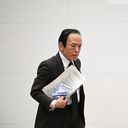With Japan's latest move, the era of negative interest rates is over

Global central bankers, desperate to jolt post-financial crisis economies out of a stagnant state and stoke inflation, embarked on a grand experiment in the 2010s — pushing interest rates into negative territory. Now, that experiment is officially over.
Why it matters: Japan ended its negative interest rate policy Tuesday, the last nation to exit from once-unthinkable strategies meant to address an economy trapped by sluggish growth and deflationary conditions.
- The 2020s, however, have so far looked much different for central bankers, with inflation rather than deflation the dominant risk — leaving little reason to continue such unconventional policy.
- Even apart from changing economic conditions, the legacy of NIRP is decidedly mixed, so central banks may be reluctant to return to sub-zero rates.
Driving the news: Bank of Japan governor Kazuo Ueda announced the bank's first rate hike in 17 years on Tuesday (overnight U.S. time).
- The hike brings the policy rate into positive territory — just barely, with a range of roughly zero to 0.1%, from negative 0.1% — for the first time since 2016.
- The central bank also said it would end other stimulative policies, including the purchase of certain risky assets and a cap on how high long-term bond yields can rise.
- However, the bank said it will have a "nimble response" if market rates rise, smoothing worries that the onset of tighter money will cause disruptions to the Japanese or global financial system.
- "We reverted to a normal monetary policy targeting short-term interest rates, as with other central banks," Ueda said in Tokyo, as translated by Reuters.
Flashback: In 2016, then-BOJ governor Haruhiko Kuroda shocked markets when he introduced negative rates — following a similar effort by the European Central Bank and central banks in countries including Switzerland, Denmark and Sweden.
Where it stands: Unlike his predecessor, Ueda's announcement was much more expected — especially after a series of strong wage agreements indicated an inflation burst was sticking across the economy.
- "The likelihood of inflation stably achieving our target has been heightening, including from January through March," Ueda said, adding policy was likely to be easy for some time.
The ambiguous legacy of negative rates
Negative rates — along with quantitative easing and forward guidance — were a solution to the "zero lower bound" problem, the answer to "how do you stimulate activity?" once you've already cut rates to zero.
Yes, but: The experience didn't leave central bankers eager for a repeat.
- The stimulative benefits were ambiguous, while the popular discontent it engendered — savers don't want to have to pay the bank to deposit money, after all — was significant. And it was costly for banks.
What they're saying: "Negative interest rate policy didn't work in many countries, including Japan," Takahide Kiuchi, a former BOJ official tells Axios. "It didn't work to stimulate the economy."
- "It was criticized pretty seriously by the banks and ordinary people in 2016, so it's a very bad memory for the BOJ. I don't think they will introduce negative interest rates again," Kiuchi says.
- The pivots around the globe to negative rates prompted some to question whether that policy might become a reality in the U.S. — a question that came up after former President Trump insisted the central bank introduce it in 2019 and then again at the pandemic's onset.
The U.S. never joined the negative rates party, with the Fed leaving its target interest rate close to, but above zero.
- "[T]he Bank of Japan's surprise deployment of negative rates has so far not been well received by the markets. The question of whether central banks may be running out of tools is very much in the air," then-Fed governor Jerome Powell said at a policy meeting in 2016.
As Fed chair, Powell repeated that message at the onset of the pandemic crisis: "I know there are fans of the policy, but for now it's not something that we're considering," he said during an appearance in 2020.
- He told "60 Minutes" days later: "I would just say it's not at all settled in, you know, in economic analysis that negative rates really add much value."